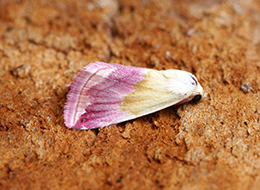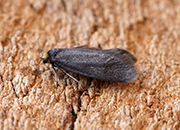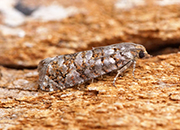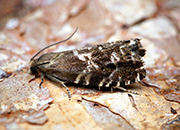Basil's Park/Bramfield Woods is a huge site situated in Central Hertfordshire, it is of significant importance due to it's size, range of deciduous trees as well as a large selection of different species of Pine, a lot of them very old and mature.
The site has been thinned out and coppiced in certain areas to allow the regeneration of understorey flora, this is fantastic for certain species of moth that feed on various wildflowers at ground level.
Saplings have also been planted in areas where felling has occured, this to me shows that the management plan for the wood seems to be sufficient to support a plethora of wildlife.
There have been many records of other wildlife over the years here, Mammals, Birds and possibly Bats? But Moths have never been recorded here before.
On that premise I was eager to start the ball rolling and to see what moths really did reside within this wood.
Access was granted and we had the whole site to choose where to put our 10 lights, to be fair we had no idea and no data to go one, so we chose a range of habitats, with some amongst woodland, others in clearings and up high, and some next to the larger stands of coniferous trees.
It was a pleasing first trip with over 40 species recorded. This is a personal high count of species for a trip out in April, since I started recording moths in 2006, which bodes well for future recording sessions
We set the traps up from 7:30pm and lights went on at around 8:15pm, all were ran until 12am whilst packing up slowly until 1am.
There were lots of expected species that feed on the surrounding trees, such as Birch, Beech, Oak and Hornbeam.
We even got the Bracken feeder Brown Silver-lines, a nice fresh and early example, to the trap nearest to last years dead plants, further re-inforcing the importance of certain habitats being sustained.
There were also some Coniferous feeding moths recorded, which is what my target species are for this year, we got a few Pine Beauties, a couple of Spruce Carpets, but better still we got a specialist pine feeding Tortrix moth and a first for the County of Hertfordshire, Gravitarmata margarotana.
Not only was it new for the site and the County of Hertfordshire, but we got 3 of them! with 2 from the light nearest some of the most mature Pine trees on the reserve.
This is a very rare moth only recently added to the British list from Kent in 2011, to date there are under a dozen records, so to get three suggests that there is a local population here. A moth that has been introduced from Europe and seems to like our ever warming climate!
Thank you to Nick Fox for sorting the access rights out and to Trevor Brownsell and Bill Last for helping out and adding to the trap and species roster.
Below is the full list, there are several small Micro moth species pending identifications.
29 Macro and 14 Micro species recorded.
Catch Report - 18/04/19 - Basil's Park/Bramfield Woods - 1x 250w Clear MV Robinson Trap, 2x 125w MV Robinson Trap, 1x twin 20w Wemite Actinic & 40w Actinic Trap, 1x twin 15w Actinic (30w) & 1x 15w Synergetic Skinner Trap & 1x 160w Mercury Blended Robinson Trap - 6 traps in total + 4 extra traps provided by Trevor and Bill
Macro Moths
Brindled Pug 30
Brown Silver-line 1
Chestnut 2
Chinese Character 1
Common Quaker 25
Clouded Drab 5
Dotted Chestnut 2
Double-striped Pug 1
Early Grey 3
Early Thorn 1
Engrailed 8
Frosted Green 20
Green Pug 1
Hebrew Character 5
Least Black Arches 1
Lunar Marbled Brown 40
Nut-tree Tussock 30
Pine Beauty 2
Powdered Quaker 1
Purple Thorn 3
Red-green Carpet 1
Satellite 2
Scalloped Hook-tip 1
Small Quaker 5
Spruce Carpet 2
Streamer 5
Twin-spotted 5
Waved Umber 1
Yellow Horned 2
Micro Moths
Adela reamurella 3
Alucita hexadactyla 1
Dyseriocrania subpurpurella 20
Cameraria ohridella 2
Emmelina monodactyla 2
Epinotia immundana 3
Eriocrania salopiella 2
Gravitarmata margarotana 3
Incurvaria masculella 1
Pammene argyrana 1
Parornix sp 1
Phyllonorycter tenerella 2
Phyllonorycter ulmifoliella 1
Semioscopis steinkellneriana 8
 |
| Alucita hexadactyla |
 |
| Brown Silver-line |
 |
| Chinese Character |
 |
| Epinotia immundana - A dark morph |
 |
| Gravitarmata margarotana |
 |
| Lunar Marbled Brown aberration |
 |
| Nut-tree Tussock |
 |
| Pammene argyrana |
 |
| Parornix sp |
 |
| Phyllonorycter tenerella |
 |
| Scalloped Hook-tip |
 |
| Semioscopis steinkellneriana |

 Musotima nitidalis
Musotima nitidalis L-album Wainscot
L-album Wainscot Feathered Ranunculus
Feathered Ranunculus Agonopterix nervosa
Agonopterix nervosa Blossom Underwing
Blossom Underwing Beautiful Marbled
Beautiful Marbled Lampronia fuscatella
Lampronia fuscatella Gravitarmata margarotana
Gravitarmata margarotana Perittia obscurepunctella
Perittia obscurepunctella Black-spotted Chestnut
Black-spotted Chestnut Cydia pactolana
Cydia pactolana










.JPG)




































